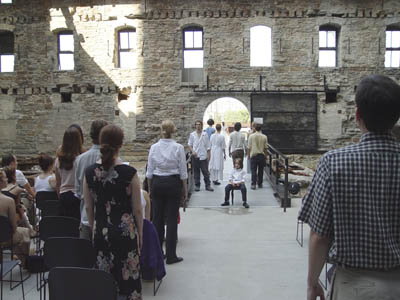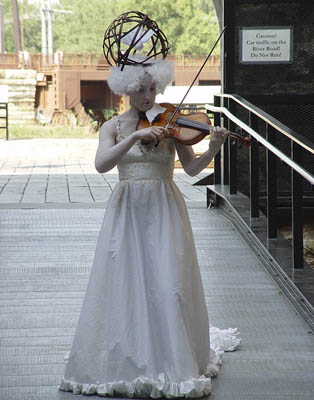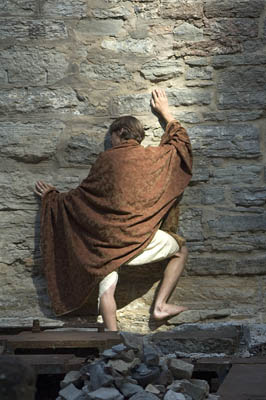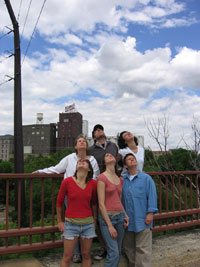Visible Fringe: What Is “Site-Specific”?
Camille LeFevre engages the question of just what kind of work is really site-specific, and what kinds of work relate to their sites in other ways. The Visible Fringe provided a number of opportunities to think about this





“Site-specific,” as an adjective and as a point of reference, has lost its specificity. Today, the term is used indiscriminately (especially in dance) to describe any movement piece that occurs off the concert stage. As a result, “site-specific” has become a catchall. As a recent example, consider the Visible Fringe performance component of this year’s Minneapolis Fringe Festival, made up of three works billed as site-specific in which movement plays an integral part: “We as Makers,” directed and choreographed by Vanessa Voskuil; Marcus Young’s solo “Pacific Avenue,” and excerpts from “LandMark: 24 Hours at the Stone Arch Bridge,” created by Local Strategy (which will be performed in its entirety beginning at sunrise on August 27).
While all of these Visible Fringe works have characteristics of site-specificity (as well as compelling moments of beauty) they cannot be considered site-specific performances. Instead, let’s call them site-influenced or site-based, because it’s time to establish some distinctions.
After 15 years of researching, seeing, writing and speaking about site-specific dance around the United States in preparation for a book on the subject, I’ve drafted a formal codification of site-specific practice in dance, and offer it up here to “set the stage” (pun intended) for subsequent discourse on site-specific dance by scholars, critics, presenters, performers and audience members around the world.
Because I am a dance critic and scholar, my definition, which continues to evolve, concerns site-specific dance and dance-theater; but one could extrapolate from it to define site-specific theater, visual art or other artistic mediums, just as I have studied public, environmental and site-specific visual art in the formulation of my definition.
For lack of a better geometry (and I’m open to suggestions), I’ve created a continuum of site-specificity in dance. While the linear shape of this continuum implies hierarchy or judgment, neither of those qualities is intended. Instead, this continuum provides a framework for describing varying degrees of “site relatedness,” either when discussing one work by a choreographer, or the evolution of an entire body of work by such site-specific choreographers as Heidi Duckler (Collage Dance Theatre, Los Angeles), Joanna Haigood (Zaccho Dance Theater, San Francisco) or Ann Carlson (New York City).
My continuum of site-specificity, and simple descriptions of each marker on the continuum, are thus:
- Concert dance: onstage in a theater
- Dance al fresco: concert dance performed outside
- Site-influenced, site-based, or site-sensitive dance: dance that responds to the physical/structural parameters, cultural/environmental characteristics of the site.
- Site-adaptive: dance created for a series of like sites that uses a core set of choreography and directions based on the type of site, but is adapted when the piece moves
- Site-specific: see below
A dance is site-specific when the choreographer receives her spatial dictation, directions for audience placement, and theatrical inspiration from the site itself; in turn, the site becomes the framework for or map of the dance. The site-specific choreographer also generates the work’s movement vocabulary and its content out of her excavation of, research into and interpretation of the site’s unique cultural matrix of characteristics, whether architectural, historical, political, economic, social and/or environmental.
As she makes the site-specific dance, the choreographer sifts these findings through the sieve of her singular artistic sensibility, stylistic preferences, and selective process of making intellectual, emotional and physical choices. (In other words, assign three different site-specific-dance choreographers to the same site and you’ll get three different dances, all site-specific.)
In the creative process of making a site-specific dance, the choreographer embodies her interpretation of the site’s cultural matrix in the performers and their movements. To a lesser degree, but no less significantly, the audience is also involved. During a site-specific dance, audience members follow the performance as it occurs throughout the site; they are often invited to interact with the performers, or are simply required to move their bodies around the site in order to watch the various decentralized activities taking place during the performance. Audiences, therefore, are not passive observers during a site-specific dance, but rather what ethnographers call “participant observers.” In this way, they too, like the dancers themselves, become an embodiment of the site’s cultural knowledge through the choreographer’s attention to and interpretation of site.
In other words, site-specific dance is of one place and no other. Without the site, the dance ceases to exist. “To move the site-specific work is to re-place it, to make it something else,” writes Nick Kaye in Site-Specific Art: Performance, Place and Documentation, echoing visual artist Richard Serra’s definition of site-specific: “To move the work is to destroy the work.”
Of course, overlap and gray areas exist in between and among these categories. Ann Carlson created “Night Light” for the Chelsea neighborhood of New York City, but there’s no denying that her “Night Light” at Jacob’s Pillow is site-specific rather than site-adaptive. Joanna Haigood’s “Picture” series, however, which premiered on grain elevators in Minneapolis before moving to New York City’s Red Hook area, could be argued as both site-specific and site-adaptive. In September, Sara Michelson reportedly will use choreographic elements from her PS 122 performance “Daylight” in New York City in “Daylight (For Minneapolis),” a dance/installation response to the architecture and space of the Walker Art Center addition. So will the piece be site-specific, site-adaptive, site-responsive or something else altogether?
Which brings us back to the Visible Fringe performances. All three have elements of site-specificity. They cause the viewer to slow down and experience a revelatory sense of place—the site in, on or through which the work occurs—in part through a process of de-familiarization that re-contextualizes that site as a location of artistic intervention. All three works, to varying degrees, invite audience participation. Of course these performances were shaped along or within the confines of the site in which they occurred. (Even if a concert dance is restaged on a lawn, the choreographer must ensure none of her dancers falls in a gopher hole.) But only “LandMark,” of which I’ve only seen snippets, comes close to being site-specific.
Voskuil’s piece, “We as Makers,” occurs in perhaps the most fantastical site in the Twin Cities: the Mill City Museum’s courtyard ruin. (The location for the dance was originally outside the Minneapolis Institute of Arts.) The orientation is proscenium; the audience is seated in rows that face the two sides of the ruin (and the arched doorway between them framing views of the Stone Art Bridge and Mississippi River) and are bisected by an aisle aligned with the walkway leading out the arched doorway and to the river. The performance begins with the seven dancers posed throughout the floor of the dirty, rock-strewn ruin. Their wonderful costumes of tattered linen tops and pants and swaths of tapestry-like fabric are in colors that echo that ruin’s tan and gold brick walls and rusty-red girders.
As Baroque music plays, one gets the sense an Elizabethan tragedy is about to unfold in a space that could be construed as the ruin of great royal hall. A woman in frilly white gown, birdcage headdress, white wig and painted red lips saunters down the walkway playing a violin like a refugee from a Louis XIV bacchanal. For there, things continue to just get downright mysterious. The dancers move amongst the rubble at a glacial pace, and often in unison. A little boy (Ansel Smolund) picks up and piles rocks; and is referred to as “my Captain” by Voskuil, who embodies the movement s of a wise old crone as she hobbles down the walkway in her marvelous blue costume, but whose words of wisdom make little sense. And he inexplicably becomes an object of worship in a disturbing scene where he’s chased across the rubble and through the rails by another woman in white, then praised by the dancers whose arms lift up in homage and fall limply to their shoulders.
The dancers find bike wheels, pans and rakes in the rubble and slowly wield them like weapons. They tumble, move their arms and gestures at a glacial pace. Toward the end, they take turns cogitating—out loud—about the purpose, meaning, creation and perfectability of art. “Is it as you, I, have described it?” one asks. Singers suddenly rise from their seats in the audience, while performing “Va Pensiero” lead the audience along the walkway and out through the door. While “We as Makers” is often visually stunning, it’s so high concept and self-reflexive to be incomprehensible. As a work in progress, however, the piece has real possibilities as a concert dance if Voskuil can find a narrative thread, flesh out her dancers with characters, create some choreographic pacing, and incorporate ideas about creativity throughout. Nonetheless, it was a treat to see the first live performance in the Mill Ruins Courtyard, a work I’d call site-influenced or site-sympathetic.
In his August 8 solo “Pacific Avenue,” Marcus Young walked, extremely slowly, down a portion of Nicollet Avenue during the noon hour. Dressed in a gray, floor-length jacket, shielded by a light-blue umbrella he’d decorated with symbols (a sliver of moon, a circle, a line), and wearing an expression of friendly interest and acknowledgement, Young was a figure that registered on nearly every passerby. While he never spoke, he’d nod and smile at those who caught his eye. I ended up watching with Voskuil, on her lunch break, and a woman from Hastings, and we talked about how people were responding to Young, how his unhurried walk in the midst of the hustle and bustle caused one to think about pace, time and how we inhabit space. Seeing this work was a joy; like having a crisp moment of Zen clarity in the midst of the hot humid day. Site-specific? Only in the sense that, to recall Heraclitus’ stream, “Pacific Avenue” cannot be dipped into (by audience/passerby or performer) more than once, but this is true of any live performance, on or off the concert stage.
Viewed from the offices of Meyer, Scherer & Rockcastle atop the Mill City Museum, all I saw of “LandMark” on August 6 were two “endurance tasks” (a man carrying a glass of water throughout the office and a man on the Stone Arch Bridge carrying a wood plank, setting it down, walking on it, picking it up again, and repeat); a “folly team” made up of dancers with red umbrellas clustering together and fanning out across the bridge; and letters assembled into the words “Eventually Why Not Now” on the “Word Hill,” a grassy slope next to the building. Nonetheless, I have high hopes for the site-specificity of this work. According to Lisa D’Amour, who is heading up the interdisciplinary team of artists that comprise Local Strategy, the team’s research has included reading, tours, studying the Mill City Museum’s exhibits, and lots of time experimenting at the site.
The team’s goal is to create an interlocking system of dance, music, theater and visual-art events, as well as processions and tours, on and around the bridge that reflect various aspects of the area’s history as the former milling capital of the world; from the physical endurance required of the mill workers to the manufacture of artificial limbs that arose to fill a need (the mills were extremely dangerous places in which to work) to the advertising campaigns of the burgeoning flour-milling companies, including “Eventually Why Not Now.” On paper at least, many of the characteristics of site-specificity exist in “LandMark.” If Local Strategy succeeds in creating a truly site-specific work, “LandMark” will be a marvelous addition to this genre of performance.
Camille LeFevre thanks Norton Owen and Jacob’s Pillow for the Research Fellowship that enabled her to broaden the ideas presented in this article.